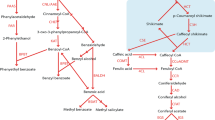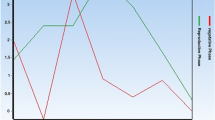Abstract
To explore the transcriptional control of phenylpropanoid pathway (PPP) involved in vanillin flavour metabolites production in tuberous roots of Decalepis hamiltonii, four PPP key genes expressed during the tuber development were identified and their mRNA expression profiles were evaluated using quantitative real-time PCR. Flavour metabolite quantification by HPLC analysis confirmed 10, 170 and 500 µg/g 2-hydroxy-4-methoxy benzaldehyde and 4, 20 and 40 µg/g vanillin in first- (3-month-old plant), second- (18-month-old plant) and third-stage tubers (60-month-old matured plant), respectively. The expression of all four genes phenylalanine ammonia lyase (DhPAL), cinnamate-4-hydroxylase (DhC4H), caffeic acid-O-methyltransferase (DhCOMT) and vanillin synthase (DhVAN) increased with flavour development from first stage to second stage. A decrease in expression from 1.9-folds to 0.1-folds and 19.2-folds to 5.2-folds for DhCOMT and DhVAN was recorded for second stage to third stage, respectively. However, a gradual increase in expression of DhPAL (up to 26.4-folds) and a constant expression pattern for DhC4H (up to 7.1-folds) was evident from second stage to third stage of flavour development. The decrease in the expression levels of DhCOMT and DhVAN in third stage shows that the second-stage tubers are more transcriptionally active towards flavour biosynthesis.








Similar content being viewed by others
References
Baek MH, Chung BY, Kim JH, Kim JS, Lee SS, An BC, Lee IJ, Kim TH (2008) cDNA cloning and expression pattern of Cinnamate-4-Hydroxylase in the Korean black raspberry. BMB Rep 41:529–536
Beena MR, Martin KP, Kirti PB, Hariharan M (2003) Rapid in vitro propagation of medicinally important Ceropegia candelabrum. Plant Cell Tissue Organ Cult 72:285–289
Bell-Lelong DA, Cusumano JC, Meyer K, Chapple C (1997) Cinnamate-4-hydroxylase expression in Arabidopsis (regulation in response to development and the environment). Plant Physiol 113:729–738
Betz C, McCollum TG, Mayer RT (2001) Differential expression of two cinnamate 4-hydroxylase genes in Valencia orange (Citrus sinensis Osbeck). Plant Mol Biol 46:741–748
Brillouet JM, Odoux E, Conejero G (2010) A set of data on green, ripening and senescent vanilla pod (Vanilla planifolia; Orchidaceae): anatomy, enzymes, phenolics lipids. Fruits 65:221–235
Burda S, Oleszek W, Lee CY (1990) Phenolic compounds and their changes in apples during maturation and cold storage. J Agric Food Chem 38:945–948
Castrejón ADR, Eichholz I, Rohn S, Kroh LW, Huyskens-Keil S (2008) Phenolic profile and antioxidant activity of highbush blueberry (Vaccinium corymbosum L.) during fruit maturation and ripening. Food Chem 109:564–572
Chakraborty D, Sircar D, Mitra A (2008) Phenylalanine ammonia-lyase-mediated biosynthesis of 2-hydroxy-4-methoxybenzaldehyde in roots of Hemidesmus indicus. J Plant Physiol 165:1033–1040
Cheng GW, Breen PJ (1991) Activity of phenylalanine ammonia-lyase (PAL) and concentrations of anthocyanins and phenolics in developing strawberry fruit. JAm Soc Hortic Sci 116:865–869
Chidambaramurthy KNC, Rajasekaran T, Giridhar P, Ravishankar GA (2006) Antioxidant property of Decalepis hamiltonii Wight & Arn. Ind J Exp Biol 44:832–837
Collazo P, Montoliu L, Puigdomènech P, Rigau J (1992) Structure and expression of the lignin O-methyltransferase gene from Zea mays L.. Plant Mol Biol 20:857–867
Dantas RL, Silva S, de M, Dantas, Guimarães AL, Lima GHC, Nascimento RP, R de S, Silva, da Silva MCA, da Santos RS, Mendonça D RMN (2016) Bioactive compounds and antioxidant activity of Tacinga inamoena (K. Schum.) fruit during maturation. Afr J Agric Res 11:1511–1518
Ehlting J, Hamberger B, Million-Rousseau R, Werck-Reichhart D (2006) Cytochromes P450 in phenolic metabolism. Phytochem Rev 5:239–270
Elkind Y, Edwards R, Mavandad M, Hedrick SA, Ribak O, Dixon RA, Lamb CJ (1990) Abnormal plant development and down-regulation of phenylpropanoid biosynthesis in transgenic tobacco containing a heterologous phenylalanine ammonia-lyase gene. Proc Natl Acad Sci 87:9057–9061
Fock-Bastide I, Palama TL, Bory S, Lécolier A, Noirot M, Joët T (2014) Expression profiles of key phenylpropanoid genes during Vanilla planifolia pod development reveal a positive correlation between PAL gene expression and vanillin biosynthesis. Plant Physiol Biochem 74:304–314
Gallage NJ, Hansen EH, Kannangara R, Olsen CE, Motawia MS, Jørgensen K, Holme I, Hebelstrup K, Grisoni M, Møller BL (2014) Vanillin formation from ferulic acid in Vanilla planifolia is catalysed by a single enzyme. Nat Commun 5037:1–14
Giridhar P, Rajasekaran T, Ravishankar GA (2005) Improvement of growth and root specific flavour compound 2-hydroxy-4-methoxy benzaldehyde of micropropagated plants of Decalepis hamiltonii Wight & Arn., under triacontanol treatment. Sci Hortic 106:228–236
Guterman I, Masci T, Chen X, Negre F, Pichersky E, Dudareva N, Weiss D, Vainstein A (2006) Generation of phenylpropanoid pathway-derived volatiles in transgenic plants: rose alcoholacetyltransferase produces phenylethyl acetate and benzyl acetate in petunia flowers. Plant Mol Biol 60:555–563
Hirata H, Ohnishi T, Watanabe N (2016) Biosynthesis of floral scent 2-phenylethanol in rose flowers. Biosci Biotechnol Biochem 80:1865–1873
Inoue K, Sewalt VJH, Ballance GM, Ni W, Stürzer C, Dixon RA (1998) Developmental expression and substrate specificities of Alfalfa caffeic acid 3-O-methyltransferase and caffeoyl coenzyme A 3-O-methyltransferase in relation to lignification. Plant Physiol 117:761–770
Jones DH (1984) Phenylalanine ammonia-lyase: regulation of its induction, and its role in plant development. Phytochemistry 23:1349–1359
Kamireddy K, Matam P, Priyanka PS, Parvatam G (2017) Biochemical characterization of a key step involved in 2H4MB production in Decalepis hamiltonii. J Plant Physiol 214:74–80
Kosar M, Kafkas E, Paydas S, Baser KHC (2004) Phenolic composition of strawberry genotypes at different maturation stages. J Agric Food Chem 52:1586–1589
Kubo I, Kinst-Hori I (1999) 2-Hydroxy-4-methoxybenzaldehyde: a potent tyrosinase inhibitor from African medicinal plants. Planta Med 65:019–022
Kundu A, Jawali N, Mitra A (2012) Shikimate pathway modulates the elicitor-stimulated accumulation of fragrant 2-hydroxy-4-methoxybenzaldehyde in Hemidesmus indicus roots. Plant Physiol Biochem 56:104–108
Liang XW, Dron M, Cramer CL, Dixon RA, Lamb CJ (1989) Differential regulation of phenylalanine ammonia-lyase genes during plant development and by environmental cues. J Biol Chem 264:14486–14492
Liu ZQ, Zhang B, Lin S, Baker PJ, Chen MS, Xue YP, Wu H, Xu F, Yuan SJ, Teng Y, Wu LF, Zheng YG (2017) Enhancement of nucleoside production in Hirsutella sinensis based on biosynthetic pathway analysis. Biomed Res Int 2017:2520347. https://doi.org/10.1155/2017/2520347
Lu S, Zhou Y, Li L, Chiang VL (2006) Distinct roles of cinnamate 4-hydroxylase genes in populus. Plant Cell Physiol 47:905–914
Maieves HA, López-Froilán R, Morales P, Pérez-Rodríguez ML, Hoffmann Ribani R, Cámara M, Sánchez-Mata MC (2015) Antioxidant phytochemicals of Hovenia dulcis Thunb. peduncles in different maturity stages. J Funct Foods 18:1117–1124
McAlister FM, Jenkins CLD, Watson JM (1998) Sequence and expression of a stem-abundant caffeic acid O-methyltransferase cDNA from perennial ryegrass (Lolium perenne). Funct Plant Biol 25:225–235
Palama TL, Khatib A, Choi YH, Payet B, Fock I, Verpoorte R, Kodja H (2009) Metabolic changes in different developmental stages of Vanilla planifolia pods. J Agric Food Chem 57:7651–7658
Peled-Zehavi H, Oliva M, Xie Q, Tzin V, Oren-Shamir M, Aharoni A, Galili G (2015) Metabolic engineering of the phenylpropanoid and its primary, precursor pathway to enhance the flavor of fruits and the aroma of flowers. Bioengineering 2:204–212
Pfaffl MW, Horgan GW, Dempfle L (2002) Relative expression software tool (REST\copyright) for group-wise comparison and statistical analysis of relative expression results in real-time PCR. Nucleic Acids Res 30:36
Pichersky E, Gang DR (2000) Genetics and biochemistry of secondary metabolites in plants: an evolutionary perspective. Trends Plant Sci 5:439–445
Podstolski A, Havkin-Frenkel D, Malinowski J, Blount JW, Kourteva G, Dixon RA (2002) Unusual 4-hydroxybenzaldehyde synthase activity from tissue cultures of the vanilla orchid Vanilla planifolia. Phytochem 61:611–620
Pradeep M, Kiran K, Giridhar P (2016) A biotechnological perspective towards improvement of Decalepis hamiltonii: potential applications of its tubers and bioactive compounds of nutraceuticals for value addition. In: Shahazad A, Sharma S, Siddiqui SA (eds) Biotechnological strategies for the conservation of medicinal and ornamental climbers—Part III. Springer, Berlin, pp 317–238
Pradeep M, Shreelakshmi SV, Giridhar P (2017a) Bioactive phenolics and antioxidant potential of Hemidesmus indicus roots. Adv Plant Sci 30(2):173–177
Pradeep M, Giridhar P, Shetty NP (2017b) Enhanced production of vanillin flavour metabolites by precursor feeding in cell suspension cultures of Decalepis hamiltonii Wight & Arn., in shake flask culture. 3 Biotech 7:376
Sachan A, Ghosh S, Sen SK, Mitra A (2005) Co-production of caffeic acid and p-hydroxybenzoic acid from p-coumaric acid by Streptomyces caeruleus MTCC 6638. Appl Microbiol Biotechnol 71:720–727
Schilmiller AL, Stout J, Weng JK, Humphreys J, Ruegger MO, Chapple C (2009) Mutations in the cinnamate 4-hydroxylase gene impact metabolism, growth and development in Arabidopsis. Plant J 60:771–782
Schwab W, Davidovich-Rikanati R, Lewinsohn E (2008) Biosynthesis of plant-derived flavor compounds. Plant J 54:712–732
Sirju-Charran G, Wickham LD (1988) The development of alternative storage sink sites in sweet potato Ipomoea batatas. Ann Bot 61:99–102
Sreekumar S, Seeni S, Pushpangadan P (2000) Micropropagation of Hemidesmus indicus for cultivation and production of 2-hydroxy 4-methoxy benzaldehyde. Plant Cell Tissue Organ Cult 62:211–218
Tamura K, Stecher G, Peterson D, Filipski A, Kumar S (2013) MEGA6: molecular evolutionary genetics analysis Version 6.0. Mol Biol Evol 30:2725–2729
Thornell K, Vedavathy S, Mulhooll DA, Crouch NR (2000) Parallel usage pattern of African and Indian periplocoids corroborate phenolic root chemistry. South Afr Ethnobot 2:17–22
Wang J, Liu H, Zhao J, Gao H, Zhou L, Liu Z, Chen Y, Sui P (2010) Antimicrobial and antioxidant activities of the root bark essential oil of Periploca sepium and its main component 2-hydroxy-4-methoxybenzaldehyde. Molecules 15:5807–5817
Wanner LA, Li G, Ware D, Somssich IE, Davis KR (1995) The phenylalanine ammonia-lyase gene family in Arabidopsis thaliana. Plant Mol Biol 27:327–338
Wu X, Wu J, Luo Y, Bragg J, Anderson O, Vogel J, Gu YQ (2013) Phylogenetic, molecular, and biochemical characterization of caffeic acid O-methyltransferase gene family in Brachypodium distachyon. Int J Plant Genom. https://doi.org/10.1155/2013/423189
Yamada T, Tanaka Y, Sriprasertsak P, Kato H, Hashimoto T, Kawamata S, Ichinose Y, Kato H, Shiraishi T, Oku H (1992) Phenylalanine ammonia-lyase genes from Pisum sativum: structure, organ-specific expression and regulation by fungal elicitor and suppressor. Plant Cell Physiol 33:715–725
Acknowledgements
We thank Dr. Rajashekar B. (FSAQCL, CSIR-CFTRI) for helping us in gene sequencing and Ms. Asha (CIFS, CSIR-CFTRI) for her help in performing HPLC. K.K, P.S and L.V thank CSIR for providing fellowship.
Funding
This work was funded by Science and Engineering Research Board, Department of Science and Technology, New Delhi (Grant no. EMR/2016/001049).
Author information
Authors and Affiliations
Contributions
PG participated in designing of the study drafting of the manuscript and analysis of results. LV participated in designing of degenerate primers, availing accession numbers to gene sequences and helped in performing the experiments and their analysis. PS performed the HPLC and MS analysis, statistical analysis and participated in drafting the manuscript. NPS involved in discussions and helped in improvement of manuscript. KK designed the study, identified the gene sequences, performed qRT-PCR analysis, analysed the results and drafted the manuscript.
Corresponding author
Ethics declarations
Conflict of interest
Authors of this article do not have any conflict of interest in any of the aspects.
Electronic supplementary material
Below is the link to the electronic supplementary material.
Rights and permissions
About this article
Cite this article
Kiran, K., Sonbarse, P.P., Veeresh, L. et al. Expression profile of phenylpropanoid pathway genes in Decalepis hamiltonii tuberous roots during flavour development. 3 Biotech 8, 365 (2018). https://doi.org/10.1007/s13205-018-1388-7
Received:
Accepted:
Published:
DOI: https://doi.org/10.1007/s13205-018-1388-7




